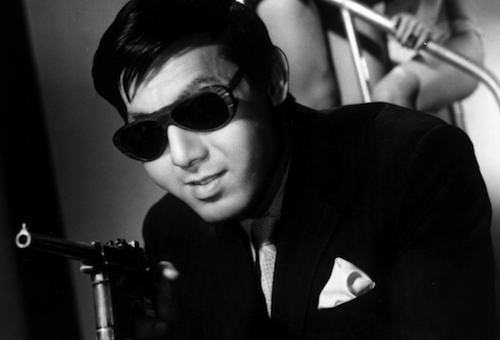
Wall Street Journal writer David Mermelstein reviews Action, Anarchy and Audacity: A Seijun Suzuki Retrospective, screening at the Billy Wilder Theater from Feb. 5 - Mar. 13. This is an excerpt from the review; the complete article can be found on the Journal website.
“Though best known in the West as part of the Japanese New Wave that also embraced auteurs like Nagisa Oshima and Shohei Imamura,the director Seijun Suzuki, now age 92, ultimately enjoyed a varied career. And the breadth of his oeuvre is the focus of 'Action, Anarchy and Audacity: A Seijun Suzuki Retrospective,' consisting of 21 features spanning 1957 to 2005 and running Friday through March 13 at the Billy Wilder Theater in Los Angeles, presented by UCLA’s Film & Television Archive with support from the Japan Foundation. (An abbreviated version of the series is also being screened at the TIFF Bell LIghtbox in Toronto through April 2.)
The retrospective accompanies the recent publication of Tom Vick’s 'Time and Place Are Nonsense: The Films of Seijun Suzuki,' the first comprehensive study in English of these movies. The series opens with the increasingly provocative B pictures Mr. Suzuki made for the Nikkatsu studio in the mid-1960s. Twisting yakuza and noir conventions to the breaking point—and beyond, some would say—the director exploded viewers’ expectations by playing down narrative cohesion and character development while elevating cinematic experimentation, including the use of unusual points of view, image manipulation and, most striking of all, emphasis on color saturation and visual contrast.
'Youth of the Beast' (1963), a breakthrough effort, stars Joe Shishido (the George Raft of Japan and the star of five of Mr. Suzuki’s pictures) as a disgraced cop who sets two rival gangs against each other in an attempt to clear both his own name and that of his now-deceased mentor. But the plot’s intricacies get overwhelmed by the material symbols of the era: booze, broads and brawn, all rendered Rat Pack style. The prominent inclusion of a gay, razor-wielding hood (the brother of a crime boss) has the paradoxical effect of placing the film squarely in its era and well ahead of its time. And the film’s final twist, though beyond improbable, is deeply satisfying.
Unfortunately, the director’s bosses at Nikkatsu were not amused, and after continued exercises in genre bending—particularly in the films 'Tokyo Drifter' (1966) and 'Branded to Kill' (1967)—Mr. Suzuki was fired, keeping him from another feature credit for a decade. But before the ax fell came three potent, socially conscious works, each dealing—in Mr. Suzuki’s unique way—with war.
'Gate of Flesh' (1964) concerns itself with the aftereffects of conflict, concentrating on a coterie of colorfully garbed prostitutes united for their own protection during the American occupation. U.S. troops are portrayed unsympathetically, but then so is everyone else in this curious study of human selfishness and the battle between the sexes.
'Story of a Prostitute' (1965), an extraordinary film, is set in Japanese-occupied Manchuria and shot in uncharacteristic, but poetically necessary, black and white. Following a group of 'comfort women' and the soldiers they serve, this lyrical and stark film charts the doomed relationship between one such woman (a fierce Yumiko Nogawa) and the sensitive corporal assisting a brutal officer to whom both are beholden. 'Fighting Elegy' (1966), also in black and white, evokes Jean Vigo’s 'Zero for Conduct' (1933) and Frank Borzage’s 'No Greater Glory' (1934) as it muses on the excesses provoked by adolescent testosterone. But there is no mistaking its bald critique of the militarism ascendant in 1930s Japan and the ruin it engendered.”
Mr. Mermelstein writes for the Journal on film and classical music.
< Back to the Archive Blog






 Mobile Navigation
Mobile Navigation

